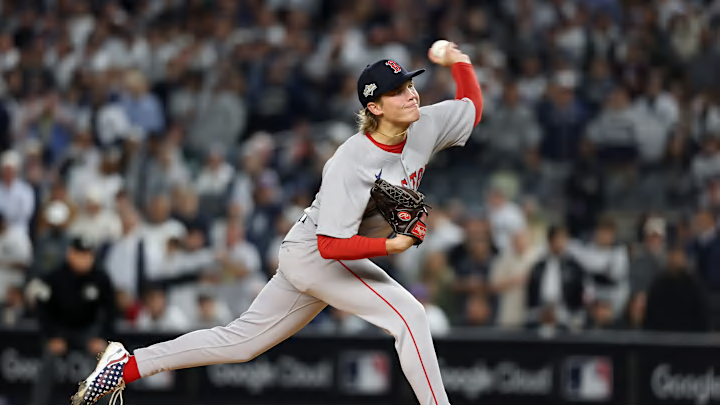The Boston Red Sox are in a mildly enviable position; they seemingly have more pitchers than they have spots for. But if anything can be learned from 2025, it is the truth of the maxim that you can never have enough pitching. Despite starting the season with at least eight viable starting options, only two remained by October. Regression, injuries, and myriad other forms of attrition would force the team to cycle through another seven starting pitchers.
With a currently projected rotation of Garrett Crochet (age 27 next season), Brayan Bello (27), Connelly Early (24), Kyle Harrison (24), and either Tanner Houck (30) or Hunter Dobbins (26), depending on health, Craig Breslow will undoubtedly target veteran additions to offload the work and stress placed on such young arms. Of those freely available, three are of particular interest.
The Frontliner
Framber Valdez (32) has served as the ace of the Houston Astros for the past four seasons, during which he has made at least 28 starts and posted an ERA no less than 14 percent better than league average each year. In a cohort somewhat thinner than those of recent years, he is certain to be the best available free agent pitcher, as well as one of the healthiest, which will ease the burden on the bullpen.
Exiting his early thirties, Valdez will not doubt desire a multi-year pact that will take him through the remainder of his productive career, if not a season or two past prudence. Given last winter’s deals given to Max Fried (8 years and 218 million dollars, starting in his age 31 season) and Corbin Burnes (6 years and 210 million dollars, starting in his age 30 season), Valdez will garner offers a little below that standard; something between five and seven years, with a total value around 180 million dollars, give or take 20 million.
The Red Sox, who have eschewed signing star pitchers since David Price in 2015, are unlikely to pay this price out of fear. If so, there are several mitigating factors that make Valdez less risky than the specter of Price; for one, he is somewhat older and therefore unlikely to receive a commitment deep into his late thirties.
Valdez also lacks the velocity-dependent success of most other aces, which deteriorates rapidly in a pitcher’s early thirties. Instead, he mixes slightly better than average strikeout and walk rates with one of the best groundball rates in either league; in no season has he allowed less than 54 percent of batted balls into the air. (David Price, by comparison, had a league-average groundball rate while carrying a much heavier workload entering free agency than Valdez has.)
In short, the Red Sox ought to make a serious pursuit of Valdez, if only to drive up his price for other contenders.
The Last Ride
Justin Verlander is well known to Red Sox fans, having faced the Olde Towne Team 26 times over the past two decades, including three times in October. Despite entering his age-43 season and with nearly four thousand professional innings on his right arm, the long-time Tiger and Astro has at least another season left, seeing that his strikeout, walk, and homerun rates are identical to those of his sophomore campaign.
Despite coming off the worst season of his career in 2024, Verlander secured a one-year contract with the San Francisco Giants for 15 million last winter, and despite early struggles, he finished the season in vintage fashion (2.87 ERA in 62.2 innings between August and September). Chasing both 300 wins and further postseason accolades, the Red Sox can further provide him with the flattering opportunity to mentor a young staff who grew up watching him dominate.
The Project
Of course, no Red Sox offseason would be complete without at least one attempt at revitalizing a starting pitcher’s career. Of the numerous formerly illuminous hurlers, one stands out in former potential, age, and recent career developments: Michael Soroka, once a future franchise ace for the Atlanta Braves, turned swingman for both Chicago clubs and the Washington Nationals.
Soroka is only 28 years old in 2026 and has shown signs of his former light in the last two seasons. While with the White Sox, he underwent a conversion to the bullpen, which seemed to bring the snap back to his pitches, after missing four seasons with a litany of injuries. This earned him a major league deal from another rebuilding club, as the Nationals brought him back to the rotation where he continued to show flashes, if also inconsistency. The Cubs, too, saw enough to trade for him at the deadline, though he only made six appearances due to injury.
The most serious of Soroka’s injuries have not been arm-related, as he suffered three major injuries or setbacks concerning his Achilles tendons between 2020 and 2022. His injuries since then have not proven long-term, a couple of shoulder issues which could easily be due to a regular workload following a long period of disuse rather than a chronic problem.
By no means should Soroka be presented as the whole and sum of Boston’s efforts this winter to mine the pitching market, but among the potential project pitchers they will peruse, he represents the most enticing option. A series of sessions with pitching coach Andrew Bailey may yet mold his capricious talent back to the form that made him an All-Star at age 21.
